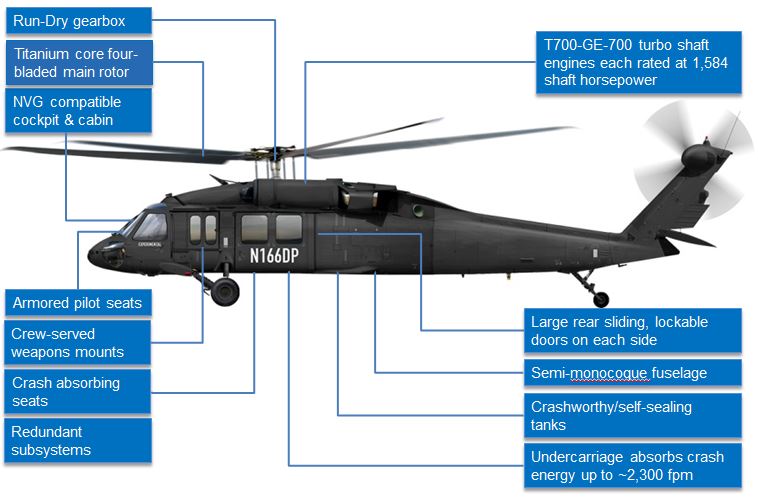Browsing Success: UH 60 Helicopter Upkeep Ideal Practices
Browsing Success: UH 60 Helicopter Upkeep Ideal Practices
Blog Article
Navigating Uh 60 Helicopter Rules and Compliance Requirements

Regulatory Structure Summary
The regulative framework regulating UH-60 helicopter operations incorporates a complex collection of guidelines and standards established by aeronautics authorities. These guidelines are designed to make sure the efficient and secure operation of UH-60 helicopters in numerous settings. The Federal Aviation Administration (FAA) plays a main duty in establishing and imposing these laws, which cover a variety of functional aspects, including airworthiness standards, pilot qualifications, upkeep needs, and functional treatments.
Compliance with these laws is vital for helicopter drivers to maintain the highest degree of safety and security and functional integrity. Failure to abide by these regulations can result in serious effects, consisting of crashes, injuries, and governing sanctions. For that reason, helicopter operators should remain notified about the most up to date regulative developments and make certain that their procedures remain in full compliance with all applicable rules and criteria.
Airworthiness Regulations and Inspections
In the middle of the regulative structure regulating UH-60 helicopter procedures, an important emphasis pushes conformity with Airworthiness Directives and carrying out comprehensive examinations to support safety standards and operational dependability. Airworthiness Directives (ADs) are issued by aviation authorities to resolve hazardous conditions in aircraft, including the UH-60 helicopter, and mandate certain activities to be taken by proprietors or drivers. Conformity with ADs is necessary, and failure to comply with these directives can result in severe effects, including grounding of the aircraft.
Routine assessments are extremely important to ensuring the airworthiness of UH-60 helicopters. By sticking to a rigorous inspection regimen, operators can detect and deal with potential problems immediately, therefore improving the security and integrity of UH-60 helicopter operations.
Pilot Credentials and Training

Pilot training for UH-60 helicopters is thorough and covers a vast array of subjects, including aircraft systems, emergency procedures, navigation, and mission-specific training. In addition, pilots undertake simulator training to practice numerous emergency situations in a controlled atmosphere. This training aids pilots create the required abilities to handle difficult scenarios successfully.


Furthermore, recurring training and expert development are crucial for UH-60 pilots to stay present with the most recent regulations, innovation, and finest techniques. By purchasing pilot credentials and training, drivers can improve safety and security, optimize performance, and make sure compliance with regulative demands in the operation of UH-60 helicopters.
Operational Limitations and Needs
Pilot qualifications and training work as the structure for recognizing the functional constraints and needs related to UH-60 helicopter operations (uh 60). These functional limitations are implemented to guarantee the safety and security of the staff, passengers, and the airplane itself. Operational restrictions may consist of factors such as weather problems, weight constraints, altitude restrictions, and operational limits. It is vital for pilots to be well-versed in these limitations to make educated decisions during trip operations. Additionally, conformity needs, such as adhering to certain flight courses, interaction procedures, and emergency procedures, are essential for keeping operational safety and security and governing conformity. Pilots should view website remain present with all functional limitations and demands through regular training, briefings, and reviews to reduce dangers and guarantee risk-free and efficient UH-60 helicopter operations. By prioritizing adherence to these functional standards, pilots can boost the total safety and security and performance of their objectives while upholding regulatory standards.
Emergency Procedures and Conformity Screening
Reliable emergency situation procedures and thorough conformity testing are essential components of maintaining operational safety and security and regulative adherence in UH-60 helicopter procedures. Emergency procedures include protocols for different scenarios, including engine failings, fires, hydraulic concerns, and more. Pilots and team participants have to be skilled in these procedures to react promptly and properly in emergencies. Routine conformity testing guarantees that the helicopter satisfies all regulatory needs stated by air travel authorities. This screening involves detailed evaluations, checks, and analyses to verify that the aircraft is airworthy and in compliance with all suitable laws.
In addition, conformity screening might include simulations of emergency situations to assess the staff's response best site and the helicopter's efficiency under anxiety. By prioritizing emergency procedures and compliance screening, UH-60 drivers can mitigate threats and show their commitment to security and regulatory compliance.
Conclusion
Finally, adherence to regulative structure, compliance with airworthiness directives, pilot credentials and training, functional limitations, and emergency situation procedures are important for navigating the policies and requirements of running a UH-60 helicopter. uh 60. It is crucial for drivers to focus on safety and security and make sure complete click site compliance with all relevant guidelines to maintain the airworthiness and operational integrity of the aircraft
Browsing the regulatory landscape surrounding UH-60 helicopter procedures requires a nuanced understanding of the elaborate internet of rules and compliance demands.Conformity with these policies is necessary for helicopter drivers to maintain the highest levels of safety and functional integrity.Among the regulatory structure regulating UH-60 helicopter operations, a vital emphasis exists on conformity with Airworthiness Directives and performing complete evaluations to maintain safety requirements and functional reliability.Effective emergency situation treatments and extensive conformity screening are vital elements of keeping functional security and governing adherence in UH-60 helicopter operations. Regular conformity screening ensures that the helicopter satisfies all governing needs established forth by aviation authorities.
Report this page